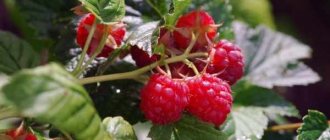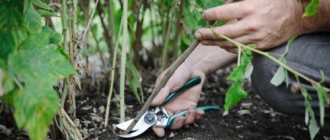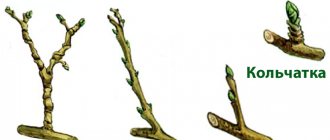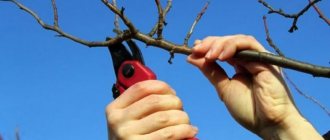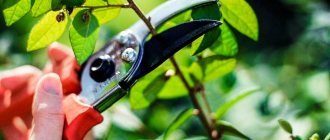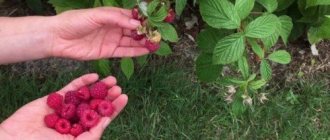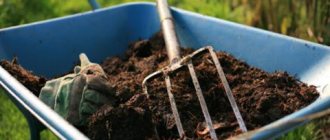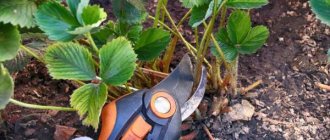Caring for cherries after planting in the countryside necessarily includes a number of measures to protect the tree, as well as to increase its fruitfulness. Today, how to care for cherries so that they regularly produce rich harvests is a whole science. Pruning cherry trees in the fall helps this fragile tree better withstand winter hibernation. In summer and spring, excess branches are removed mainly in order to obtain a more abundant and tasty harvest. There is a misconception that removing unnecessary branches can cause irreparable harm to the tree.
Among amateur gardeners there is a very popular myth that cherries do not recover well after interference in their vital functions. Therefore, pruning a cherry tree in the fall may result in the tree not being able to withstand the winter cold. Experienced gardeners know that this is absurd. The reasons why a tree does not survive winter well lie not in the shortening of the branches itself, but in improper pruning. How to properly prune cherries in the fall and when is the best time to carry out this procedure, you will learn from this article.
Latest articles about gardening
Using hedgehogs for processing potatoes
Types of seedling cassettes and their use
Hazelnut - how it grows and blooms, growing a nut in the garden
Why do you need autumn pruning for cherries?
The benefits of this procedure are quite great:
- formation and correction of tree crowns;
- rejuvenation by removing old diseased branches;
- elimination and prevention of excessive thickening of the cortex;
- potential increase in future yields.
It is noteworthy that there are different pruning methods - the thinning method (when the branches are cut off at the very base) and the shortening method (the branch is not completely cut off). Both methods are used in the cultivation of cherries and other fruit species. It is believed that pruning a plant weakens it, making it more susceptible to frost. This is partly true when inexperienced gardeners use incorrect pruning techniques.
Preparing for winter
Cherry is considered a heat-loving crop, so in each region it is prepared for winter differently. If the crop is grown in an area with a mild climate, where winter passes quickly and with warm temperatures, then preparation will be minimal, and shelter will not be required at all. All that is required from the gardener is to trim the shoots in time, finally water the soil well, and apply fertilizer for future fruiting.
In the middle zone, cherries need to be prepared more carefully, since the weather can be changeable: in addition to applying fertilizers and annual pruning after watering, the soil near the tree trunk should be well mulched (the thickness of the mulch layer is at least 3-4 cm) so that the roots do not freeze over the winter. When snow falls in winter, it will serve as additional protection from frost.
If the crop is grown in Siberia and the Urals, then it must be covered for the winter, otherwise the plantings will not survive until spring. In unfavorable regions, you should choose cold-resistant varieties for planting: they adapt to low temperatures, withstand long, harsh winters, and in the spring, as the weather warms, they actively gain growth.
Whitewashing of trunks
A mandatory procedure for preserving cherry trees on the site is whitewashing the trunks. It is carried out for several reasons:
- protect the bark from active winter sun and frost;
- protect the tree from temperature changes;
- repel rodents and pests whose larvae settle in the bark.
Both adult and young cherries are subject to whitewashing. It is carried out in October and November, when all other preparatory procedures come to completion. The entire trunk needs to be whitewashed, starting from the root collar and up to the first skeletal branch located on the lower tier. Sometimes the lower shoots are captured and whitened about 1/3 of the entire length.
For whitewashing the trunk, ordinary water-based paint is suitable; sometimes water-dispersion paint is used. The color of the helmet must be white so that the bark can “breathe.” Laundry soap, PVA glue, clay and milk are often added to the liquid. This combined mixture adheres better to the bark and lasts longer.
Attention!
Begin whitewashing a cherry tree in dry weather, then the paint will dry quickly and adhere securely to the bark.
What tools are needed for pruning cherries?
To fully maintain a small garden you need 5 tools:
- pruner;
- lopper;
- brush cutter;
- hacksaw;
- scissors.
This is a necessary minimum that should be in the arsenal of every self-respecting owner.
Whatever garden tool we are talking about, any of them should be:
- sharpened;
- withstand significant forces;
- be light and have a comfortable handle;
- be safe in operation and during transportation, have a bright color that makes it easier to find;
- be light in weight;
- have the ends as narrow as possible in order to penetrate to the base of the branches without damaging the rest.
Latest articles about gardening
Description of the raspberry variety “Bryansk Diva” with photographs
Raspberry Hercules: description, varieties, photos, reviews, care, pruning
When is it best to prune trees in autumn or spring?
Types of cherry pruning
To properly prune any fruit tree, it is very important to be able to identify the type of branches.
There are 3 types:
- vegetative - form the basis of the plant skeleton;
- incremental - grow annually during the growing season;
- bouquet - are the place of formation of fruit buds.
Tools for work
Necessary tools for pruning
To carry out proper pruning, you need to arm yourself with:
- pruning shears or a garden knife, allowing you to work with small branches;
- saw for removing large branches;
- stepladder or ladder.
In addition, you will need garden varnish to cover large cuts. To avoid infection, pruning is done only with a well-disinfected tool.
Do not use a dull knife or a rusty saw - this will often cause irreparable damage to the wood.
Pruning cherries in autumn
Like all stone fruits, cherries should be pruned in the fall. This procedure helps to properly prepare the tree for wintering. Many young gardeners harm the plant by refusing to crown cherries at this time of year for fear of damaging them. It is not recommended to touch only seedlings of the first year of planting, since they risk not surviving the winter in this case.
The period when pruning is allowed varies depending on the region. In the northern regions, it is advisable to complete the formation of the crown at the end of August - the first half of September, and in the southern regions the tree is crowned in November. The main conditions indicating the correct choice of pruning time are the following:
- sap flow has stopped, indicating the end of the growing season;
- There are no frosts at night yet.
Some tips
In the absence of experience, many gardeners make mistakes when cutting cherry trees in the fall. But this event must be carried out in order to constantly obtain a large harvest. In addition, pruning trees in the fall contributes to the successful wintering of the plant.
When answering the question of how to prune cherries in the fall to ensure a good harvest, experienced gardeners recommend following the following tips for beginners:
- Properly prune cherries before frost.
- Unlike other fruit plants, the buds on a cherry tree are located at the ends of the branches, and not along the entire length. Therefore, during shearing, they are completely removed or simply thinned out, leaving 2-3 pieces on each shoot. This method maintains high yields.
- Complete rejuvenation of cherries can be conveniently done with a saw.
- The tree is trimmed, trying to give all annual branches a length of 30 cm. With this method there will be no bare branches.
- Root growth is removed annually, as it significantly reduces yield.
- For tree cherry, the optimal height is 3 m. Therefore, as soon as the tree reaches this point, the top is trimmed.
- The crown of this crop quickly overgrows. Therefore, pruning work is carried out annually. Otherwise, the growth of fruiting shoots stops.
- They don’t remove all the branches on the cherry tree. Be sure to leave annual shoots and bouquet branches.
Until now, experts have differing opinions on when it is better to prune cherries in spring or autumn. But long-term observations have shown that cutting the plant in autumn brings much more benefit. It also helps to better survive the winter cold. The goal of autumn cultivation is not to completely change the appearance of a tree or bush, but to correct the shape of the crown and sanitary cleansing. It is necessary to improve productivity and prevent various diseases.
Pruning bush cherries in autumn
Rejuvenation must be carried out after the shoots have reached a length of fifty centimeters or more.
Trimming scheme:
- branches are removed into the flesh of the first significant branching;
- thinning of shoots is carried out;
- in the event that you need to remove too many branches, you do not need to do this at one time; it is better to divide the necessary work into several seasons, since otherwise the plant can be greatly weakened.
Processing bushy varieties
Felt cherry pruning diagram
The main task when working with bushy varieties is to enable the plant to grow and develop actively. This cherry bears fruit on shoots that are already one year old - they can be pruned, but cannot be removed to avoid the branch drying out. Bushy plants have a predisposition to thickening. They need to be trimmed without leaving stumps, otherwise gum formation may occur, which will provoke the appearance of pests and diseases.
An annual growth of less than 20 cm gives reason to start shaping the crown. First, you need to carry out the so-called sanitary pruning - clean the plant from damaged, broken branches, parts that do not sprout. The remaining branches are shortened to the first strong branches. You can safely remove shoots that have reached 0.5 meters in length - they will be able to quickly recover, accelerating their growth.
The main rule that should be followed when pruning a bush variety is that the less growth the cherry tree gives during the season, the more intensive the cleaning is. An overgrown shrub will have to be formed in several stages - if there are too many shoots, the cherry tree may not recover from one-time removal.
The bushy type includes the felt cherry, beloved by many, which grows up to three meters in height and generously bestows its fruits during the season. This variety pleases not only with its active fruiting and decorativeness, but also with its low predisposition to the development of thickening shoots. This makes it easier to clean the bush in the fall.
However, regular pruning of felt cherry trees cannot be taken lightly: it is considered one of the most important procedures. By pruning you can significantly increase the lifespan of a bush. The plant needs systematic thinning of the crown - you need to leave 10-12 of the most powerful shoots.
It is necessary to take into account that this variety mainly bears fruit on annual branches, and therefore they are almost never shortened. Occasionally you come across shoots that grow up to 0.5 m - they can be shortened by about a third of the length. If the ends of branches are exposed on mature trees, then 1/2 or 1/3 of the length must be removed.
During sanitary pruning, broken and infected parts of the bush are removed. Rejuvenating measures include cutting off some of the side shoots into a ring - the central part of the crown and skeletal-forming branches are not affected. Then shortening is done. The old crown is cut off only after new shoots appear.
Pruning cherry trees in autumn
The trailers for pruning tree-type cherries are similar to those for bush-type cherries, but there are also differences. In addition to thinning the crown, it is necessary to shorten shoots that are too long.
When the tree reaches the required height, its growth must be stopped, which is done by transferring the main conductor and skeletal branches to a side branch.
Caring for cherries is an important process. It is necessary to know the technology of pruning a plant so as not to damage or weaken it. The technique for rejuvenating cherries depends on the age of the plant, the type of crown, time and skills of the gardener. With proper care, cherries will annually delight you with fragrant flowers and juicy berries.
Rejuvenation
Anti-aging activities should be carried out gradually - as a rule, this takes several years. You need to give the old cherry time to fully recover.
You can tell that a tree needs pruning based on certain signs. On bush varieties, bare ends of the branches will be noticeable - this indicates that it is necessary to remove a third or even half of the length.
The tree-like old cherry tree bares its base. As for growth, over the course of a year it decreases to 10-15 cm. In this case, growth can be stimulated by pinching annual shoots. In addition, the plant will need rejuvenating pruning on three-year-old wood. When the ends of large branches located deep in the crown begin to dry out, rejuvenating pruning should be done on the side branches growing on five-year-old wood.
